Schools
What do these photos tell you about how schools were like?
Log School In Pine Grove (1892)
This photo was taken in Pine Grove, Colorado (now the town of Pine). It shows a one-room, log school house, 11 students, and their teacher.
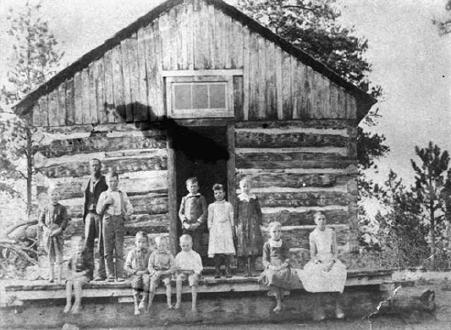
Photo: Denver Public Library, Western History Collection
More About This Topic
The early settlers of Colorado thought the education of children was very important. A schoolhouse like the one in this photo often was the first public building in a community.
Their Own Words
"The men set a day, brought their sod cutters, wagons, spades, and carpenter tools and went to work. In a remarkably short time the building was up, the windows and door installed, and the two, little frame structures out back, one labeled boys, the other girls, completed. A teacher was found and school was underway. All eight grades were taught in the one room."
Source: Glen R. Durrell, "Homesteading in Colorado," Colorado Magazine, 51 (1974): 101-102.
School House Near Limon
This is a photo of a one-room school near Limon in eastern Colorado. The photo taken in June 1907 shows Mrs. Shanahan, the teacher, and her eleven students. The schoolhouse was built of sod.
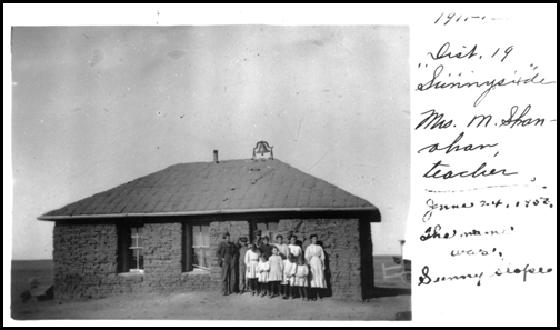
Photo: Denver Public Library, Western History Collection
More About This Topic
Many small communities in Colorado had one-room schools. Children of different ages sat together in a single classroom with one teacher. The teacher spent time with some students while others worked on assignments. Sometimes older students helped teach the younger ones.
Their Own Words
"I still have a soft spot in my heart for the one-room school. It is true, perhaps, that you cannot have as many activities--of some kinds--as you can in graded schools. But, when you put eighteen or twenty kids, ages six to sixteen together, you will have plenty of activity. While one class was reciting, the rest were supposed to be studying. You usually listen in, however, to the grades ahead of you because you would be covering the same ground later on…."
"We had the usual spelling and arithmetic papers to hand in. We also had spelling bees and "cyphering" matches. The possibility of having someone younger or in a lower grade "spell you down" was a powerful incentive to study. Having older children help the younger ones with their lessons was also a useful learning tool….
"At any rate, the system made schooling possible and it fitted the needs of our times."
Source: Glen R. Durrell, "Homesteading in Colorado," Colorado Magazine, 51 (1974): 102-103.
Log School Near Walden (1887)
One-room log school house near Walden, Colorado in North Park. It shows children in front of the school. Most of the children are on horseback. The photo was taken in 1887 or 1888.

Photo: Denver Public Library, Western History Collection
More About This Topic
In rural areas in the 1800s, most children walked to school. In ranch country like North Park, at least some children rode horses to school.
Their Own Words
“The school [on Ohio Creek] was a success from the start. Some of the children came eight or ten miles to attend but all of the ranchmen had ponies which were plentiful and cheap and even young children rode. It was decided that the school must have a library, so an entertainment was given at the school house to raise funds for the purpose. The entertainment was a great success; certainly the performers said so. All was by home talent except one friend who came up from Gunnison City to help us.”
Source: H. C. Cornwall, “Ranching on Ohio Creek, 1881-1886,” Colorado Magazine, 32 (January 1855): 23.
One Room School Near Ramah
This is a one-room school near Ramah, Colorado, a town east of Colorado Springs. The building is made of boards sawed at a sawmill.
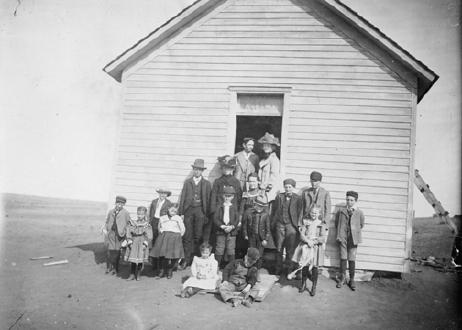
Photo: Denver Public Library, Western History Collection
More About This Topic
In many Colorado communities, the first schools as well as the first houses were built of logs or sod. Most people thought of them as temporary buildings. As soon as they could afford it, the community built a “proper” frame school building like this one in Ramah.
Their Own Words
"I went to school in a sod school house near Latham. It had a rough board floor and a dirt roof. There was a window on each side and there was a windowpane. The walls were about two feet thick and we used to pile our wraps in the windows for there was no place to hang them. Sometimes a button would strike against a pane and break it or the boys would throw a ball through. Whenever it rained the roof would leak for an hour or so afterwards."
Source: Mrs. Jennie Lucas (1941), "Pioneer Education," WPA Interviews, Box 5, Denver Public Library.
Frame School In Sterling (1884)
This photo taken in 1884 shows the elementary school in Sterling, Colorado. It also shows students and teachers standing in front of the school. This was a large wooden frame building.
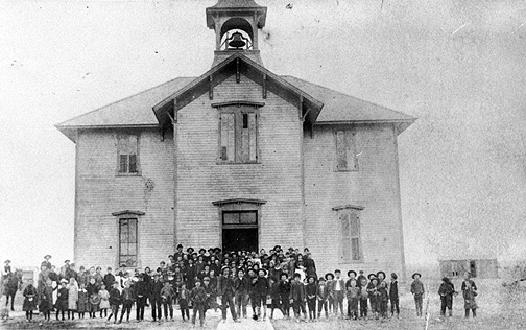
Photo: Colorado Historical Society
More About This Topic
Towns like Sterling outgrew their one-room schools. They built larger frame buildings with several rooms. In the elementary school in this photo, two grades could share a room. The building had two large rooms on each floor. Only in big cities were schools large enough for each grade to have its own room.
School House At Mosca
This is a photo of the school at Mosca in Alamoso County, Colorado. It is a 12-grade school attended by students from grade 1 through high school. It was a wooden frame building.
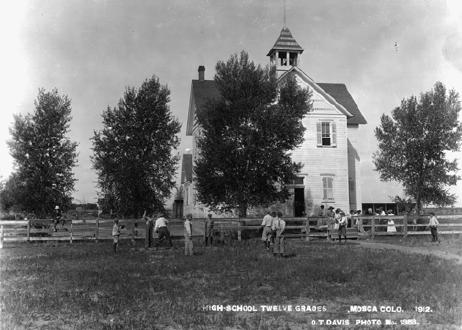
Photo: Denver Public Library, Western History Collection
More About This Topic
When Colorado was first settled, few communities had high schools. Most children quit school after the 8th grade. Those who attended high school had to move to a large town or city. Then, in the early 1900s, many smaller communities began building high schools. The town of Mosca built a school large enough for elementary and high school students to use the same building.
Three Schools In Craig
This photo taken in Craig, Colorado in 1917 shows three school buildings. The earliest school was the small building on the left. The two-story frame building on the right was built in 1891 or 1892. It would be replaced by the brick building, which was nearly finished when this photo was taken.

Photo: Denver Public Library, Western History Collection
More About This Topic
As communities grew they built new school buildings. The first log or sod schools were replaced by wooden frame buildings. In time, most of those were replaced with buildings made of brick. This photo shows how the school in Craig expanded from a one-room school to a large brick building. Most of the school buildings built in Colorado after 1900 were brick buildings.
Their Own Words
“The new high school building of red, kiln-baked bricks, supporting sandstone trim, and date plate—1888—boasted hot water heating and furnace room. Tall, two-sashed windows admitted light through double panes [of glass]. Dark green shades with long, ring-tipped cords shut out the sun, provided the wind wasn’t blowing. The building itself reflected dignity—even a little grandeur—with side front doors, a spacious hallway leading to ground-floor classrooms, winding stairs, and a magnificent belfry topped by four ornately shingled arches beneath the swiveling lightning rod. The stairs rose to second-floor classrooms, superintendent’s office and large assembly hall.”
Source: Gladys Seevers, “Amo, Amas, Amat – Lamar High School – 1897,” in Margaret J. Lehrer, ed., Up the Hemline (Colorado Springs, CO: Williams and Field, 1975): 35.

